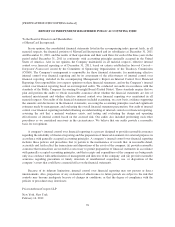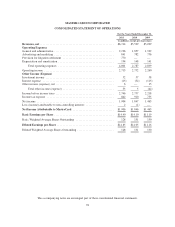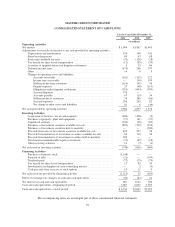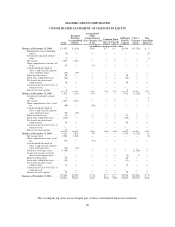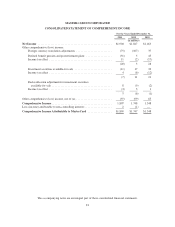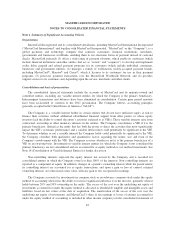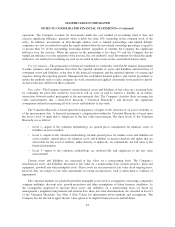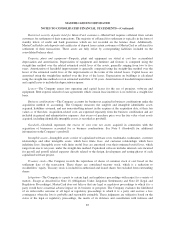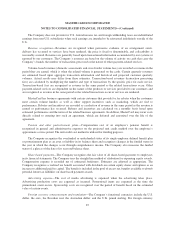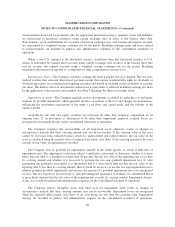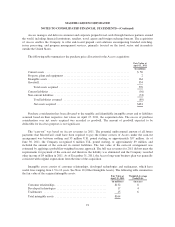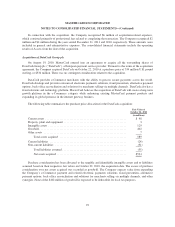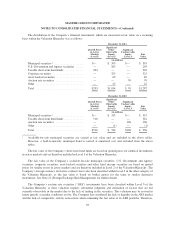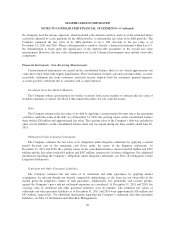MasterCard 2011 Annual Report Download - page 90
Download and view the complete annual report
Please find page 90 of the 2011 MasterCard annual report below. You can navigate through the pages in the report by either clicking on the pages listed below, or by using the keyword search tool below to find specific information within the annual report.MASTERCARD INCORPORATED
NOTES TO CONSOLIDATED FINANCIAL STATEMENTS—(Continued)
external legal counsel. The actual outcomes of these proceedings may materially differ from the Company’s
judgments. Legal costs are expensed as incurred and recorded in general and administrative expenses.
Settlement and other risk management—MasterCard has global risk management policies and procedures,
which include risk standards to provide a framework for managing the Company’s settlement exposure.
Settlement risk is the legal exposure due to the difference in timing between the payment transaction date and
subsequent settlement. MasterCard’s rules generally guarantee the payment of certain MasterCard, Cirrus and
Maestro-branded transactions between its customers. The term and amount of the guarantee are unlimited.
Settlement exposure under the guarantee is short term and typically limited to a few days. In the event that
MasterCard effects a payment on behalf of a failed customer, MasterCard may seek an assignment of the
underlying receivables. Subject to approval by the Company’s Board of Directors, customers may be charged for
the amount of any settlement losses incurred during the ordinary activities of the Company. MasterCard has also
guaranteed the payment of MasterCard-branded travelers cheques, which are no longer being issued, in the event
of issuer default. The term of the guarantee is unlimited, while the amount is limited to cheques issued but not yet
cashed. The Company may also have other guarantee obligations in the course of its business. The Company
accounts for each of its guarantees issued or modified after December 31, 2002, the adoption date of the relevant
accounting standard, by recording the guarantee at its fair value at the inception or modification of the guarantee
through earnings. To the extent that a guarantee is significantly modified subsequent to the inception of the
guarantee, the Company remeasures the fair value of the guarantee at the date of modification through earnings.
The Company enters into agreements in the ordinary course of business under which the Company agrees to
indemnify third parties against damages, losses and expenses incurred in connection with legal and other
proceedings arising from relationships or transactions with the Company. As the extent of the Company’s
obligations under these agreements depends entirely upon the occurrence of future events, the Company’s
potential future liability under these agreements is not determinable. See Note 5 (Fair Value) and Note 21
(Settlement and Other Risk Management).
Derivative financial instruments—The Company accounts for all derivatives, whether designated in hedging
relationships or not, by recording them on the balance sheet at fair value in other assets and other liabilities,
regardless of the purpose or intent for holding them. The Company’s foreign exchange forward contracts are
included in level 2 of the Valuation Hierarchy as the fair value of these contracts are based on broker quotes for
the same or similar instruments. Changes in the fair value of derivative instruments are reported in current-period
earnings. The Company did not have any derivative contracts accounted for under hedge accounting as of
December 31, 2011 and 2010.
Income taxes—The Company follows an asset and liability based approach in accounting for income taxes
as required under GAAP. Deferred income tax assets and liabilities are recorded to reflect the tax consequences
on future years of temporary differences between the financial statement carrying amounts and income tax bases
of assets and liabilities. Deferred income taxes are displayed as separate line items or are included in other
current liabilities on the consolidated balance sheet. Valuation allowances are provided against assets which are
not more likely than not to be realized. The Company recognizes all material tax positions, including all
significant uncertain tax positions in which it is more likely than not that the position will be sustained based on
its technical merits and if challenged by the relevant taxing authorities. At each balance sheet date, unresolved
uncertain tax positions are reassessed to determine whether subsequent developments require a change in the
amount of recognized tax benefit. The allowance for uncertain tax positions is recorded in other current and
noncurrent liabilities on the consolidated balance sheet.
The Company records interest expense related to income tax matters as interest expense in its statement of
operations. The company includes penalties related to income tax matters in the income tax provision.
86


